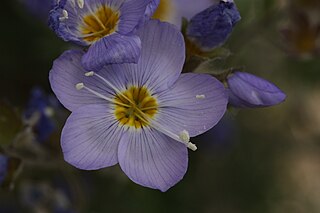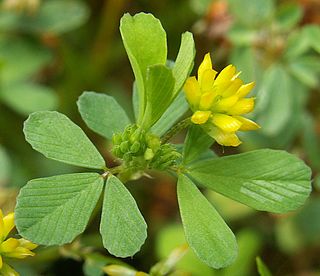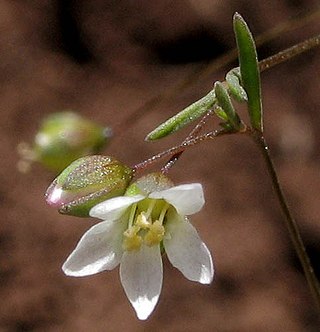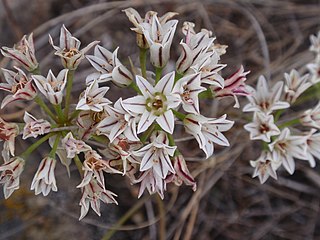
Polemonium reptans is a perennial herbaceous plant native to eastern North America. Common names include spreading Jacob's ladder, creeping Jacob's ladder, false Jacob's ladder, abscess root, American Greek valerian, blue bells, stairway to heaven, and sweatroot.

Acer micranthum, the small-leaved maple, is a species of flowering plant in the family Sapindaceae in the snakebark maple group, native to Japan, on Honshū, Kyūshū and Shikoku. Its Japanese name is the Komine maple.

Polemonium boreale, the northern Jacob's-ladder or boreal Jacobs-ladder, is a plant native to the most of the high arctic. In Greenland it is found only in a small area on the east coast. It is not very common.

Polemonium, commonly called Jacob's ladders or Jacob's-ladders, is a genus of between 25 and 40 species of flowering plants in the family Polemoniaceae, native to cool temperate to arctic regions of the Northern Hemisphere. One species also occurs in the southern Andes in South America. Many of the species grow at high altitudes, in mountainous areas. Most of the uncertainty in the number of species relates to those in Eurasia, many of which have been synonymized with Polemonium caeruleum.

The Polemoniaceae are a family of flowering plants consisting of about 25 genera with 270–400 species of annuals and perennials native to the Northern Hemisphere and South America, with the center of diversity in western North America.

Polemonium viscosum, known as sky pilot, skunkweed, sticky Jacobs-ladder, and sticky polemonium, is a flowering plant in the genus Polemonium native to western North America from southern British Columbia east to Montana and south to Arizona and New Mexico, where it grows at high altitudes on dry, rocky sites.

Polemonium acutiflorum, known as tall Jacob's-ladder, is a flowering plant in the family Polemoniaceae. It is native to western Canada and Alaska.

Polemonium carneum is a plant native to the northwestern United States west of the crest of the Cascade Range, from Washington south through Oregon to the San Francisco Bay Area in California.

Trifolium dubium, the lesser trefoil, suckling clover, little hop clover or lesser hop trefoil, is a flowering plant in the pea and clover family Fabaceae. This species is generally accepted as the primary plant to represent the traditional Irish shamrock.

Polemonium eximium, the skypilot or showy sky pilot, is a perennial plant in the phlox family (Polemoniaceae) that grows at high altitudes. It is endemic to the Sierra Nevada in California where it grows in the talus of the high mountain slopes.

Hesperolinon micranthum is a species of flowering plant in the flax family known by the common name smallflower dwarf flax. It is native to the west coast of North America from Oregon to Baja California. It may occur in Nevada. It grows in a number of open habitats, often on serpentine soils. This is a spindly annual herb producing a very thin stem 5 to 20 centimeters in height. Its small, sparse leaves are linear in shape. The tiny flowers have five white or pink-veined white petals each less than four millimeters long and protruding stamens with white or purple anthers.

Allium lacunosum is a species of wild onion known by the common name pitted onion. It is endemic to California, where it is a common member of the flora in many types of habitat, from bayside to mountain to desert.

Polemonium californicum is a species of flowering plant in the phlox family known by the common names moving polemonium, low Jacob's-ladder, and California Jacob's ladder. It is native to the northwestern United States, where it grows in shady and moist habitat, such as mountain woodlands. It is a hairy, glandular rhizomatous perennial herb forming clumps of several decumbent to erect stems 30 to 50 centimeters in maximum height. The leaves are up to 20 centimeters long and are compound, made up of several pairs of oval to lance-shaped leaflets. The leaflet at the tip of the leaf is often fused to the pair behind it. The inflorescence is a crowded cluster of bell-shaped flowers each up to 1.5 centimeters wide. The flower is blue or purple with a yellow center and a whitish tubular throat. The fruit is a capsule.

Polemonium occidentale is a species of flowering plant in the phlox family known by the common names western polemonium and western Jacob's-ladder. There are two subspecies. The common ssp. occidentale is native to western North America from British Columbia to Colorado to California, where it can be found in moist areas of many habitat types, including meadows and woodlands. There is also a rare subspecies, ssp. lacustre, which is known only from a total of three counties in Minnesota and Wisconsin, and is found only in white cedar swamp habitat there.
Trichostema micranthum is a species of flowering plant in the mint family, known by the common name smallflower bluecurls.
Packera castoreus is a rare species of flowering plant in the aster family known by the common names Beaver Mountain groundsel and Beaver Mountain ragwort. It is endemic to Utah in the United States, where it occurs only in the Tushar Mountains.
Trifolium micranthum, the slender trefoil or slender hop clover, is a plant species of the genus Trifolium in the "pea family" ; Fabaceae or Papillionaceae.

Polemonium elegans, the elegant Jacob's-ladder, is a rare species of flowering plant in the phlox family found in the United States.

Polemonium foliosissimum, the towering Jacob's-ladder, is a rare species of flowering plant in the phlox family Polemoniaceae, native to the western United States; Arizona, Colorado, Idaho, Nevada, New Mexico, Utah and Wyoming. As its synonym Polemonium archibaldiae it has gained the Royal Horticultural Society's Award of Garden Merit.

Polemonium pauciflorum, the fewflower Jacob's-ladder, is a rare species of flowering plant in the phlox family found in the United States and Mexico.
















